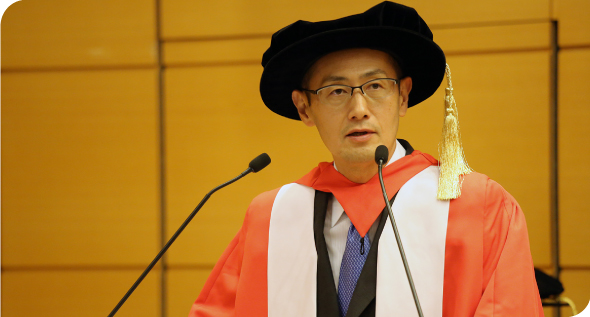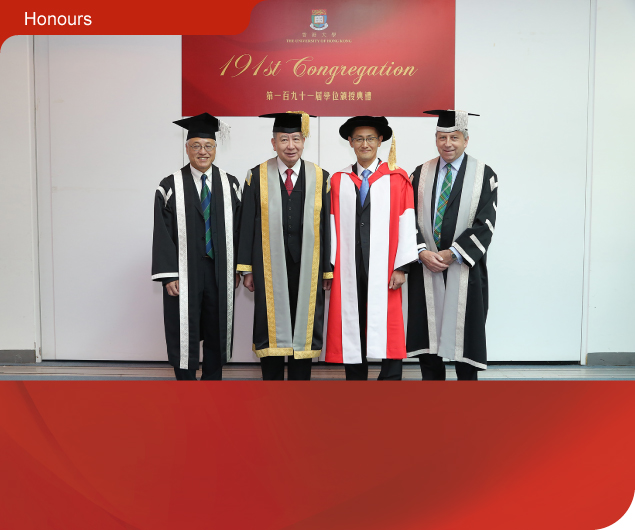Professor Shinya Yamanaka, the 2012 Nobel Laureate in Physiology or Medicine, was conferred an Honorary Degree by HKU in October in recognition of his outstanding contributions to health and research.
In 2006, Professor Yamanaka announced the holy grail of stem cell research: he had discovered how to derive stem cells from existing adult cells, rather than human embryonic cells. This freed stem cell research from the restrictions that were introduced in many countries due to ethical concerns over the use of embryonic cells.
The importance of his discovery led to numerous honours and within a few short years the Nobel Prize, but it had a humble beginning.
Professor Yamanaka first became interested in medicine when he was a boy in Japan and suffered many injuries, requiring frequent visits to the hospital. His interest in research, and stem cell research in particular, came after he received his doctorate from Osaka City University in 1993, spent three years at the Gladstone Institute of Cardiovascular Disease in California, and returned home to be assigned a job looking after the laboratory mice. The boredom of that job led him to pursue his own research, and to his discovery.
My goal as a physician-turned-scientist is to help as many patients around the world as possible, and I hope many researchers will use induced pluripotent stem cell technology as a research tool to develop new cures to various intractable diseases.
Professor Shinya Yamanaka Professor Shinya Yamanaka was conferred with the Doctor of Science honoris causa when he made a trip to HKU for the European Molecular Biology Organization (EMBO) Workshops in October, 2014.
Professor Shinya Yamanaka was conferred with the Doctor of Science honoris causa when he made a trip to HKU for the European Molecular Biology Organization (EMBO) Workshops in October, 2014.
Reprogramming cells
Stem cells are present in the embryo and develop into the cells of the brain, bones, nerves, blood, organs and other parts of the human body. They are important because they are ‘pluripotent’, meaning they can differentiate into any cell.
Professor Yamanaka effectively reversed the differentiation process. Working with the genome of mice, he and his team calculated how to add a small number of key genes to a mature and specialised adult cell to reprogramme it into a pluripotent cell. The result was called an induced pluripotent stem (iPS) cell.
The research was published to much acclaim in August 2006, on the same day a team of HKU professors happened to be visiting his laboratory, according to HKU’s Public Orator, Professor Michael Wilkinson, who presented Professor Yamanaka for the Doctor of Science honoris causa in October. “Even amidst the excitement and the demands of the press, Shinya took time to meet our colleagues and tell them about his discovery,” he said.
 Professor Yamanaka delivered a special keynote lecture entitled ‘Dissecting Human Reprogramming Toward Pluripotency’ after the Congregation ceremony.
Professor Yamanaka delivered a special keynote lecture entitled ‘Dissecting Human Reprogramming Toward Pluripotency’ after the Congregation ceremony.
A window to disease
The development of the iPS cell technique has had a number of implications. For researchers it enables them to have a steady supply of stem cells for testing and investigation. It also provides a window for learning more about diseases that are caused by cell malfunctioning because the cells of patients can be reprogrammed then induced to grow again, revealing how the diseases progress. This approach has been found suitable for studying such diseases as Lou Gehrig’s and Alzheimer’s, and for studying the effects of possible treatments.
These developments all align with Professor Yamanaka’s own stated mission: “My goal as a physician-turned-scientist is to help as many patients around the world as possible, and I hope many researchers will use iPS cell technology as a research tool to develop new cures to various intractable diseases.”
Professor Yamanaka currently is Director of the Center for iPS Cell Research and Application at Kyoto University and a Senior Investigator at Gladstone Institutes. He has also visited HKU twice, including in 2008 when he delivered the Shaw Prize Lecture.■


